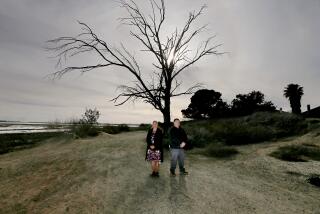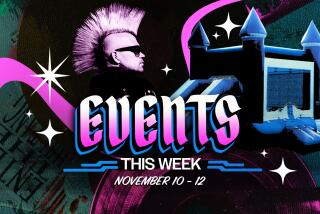Celebration of Indian Culture : The Tuj-Unga Heritage Pageant will open tonight with photography exhibits, poetry and storytelling.
- Share via
Spell that Tuj-Unga . It’s the proper American Indian spelling, says Daniel Veneciano, a curator for that city’s McGroarty Arts Center. “It means something like: Our mother, the earth,” he explains.
Not only that, but a member of the Gabrielino tribe, a people indigenous to the Los Angeles Basin, also informed Veneciano that Tuj-Unga is in fact a sacred area to some American Indians. These are a couple of things Veneciano has learned during the past few months while organizing tonight’s 6:30 opening of the Tuj-Unga Heritage Pageant, which begins by centering on contemporary American Indian culture through photography and spoken-word performance.
The evening begins with a pair of photography exhibits, including a collection of informal documentary work by Marcus Lopez, an American Indian activist and host of “Native American Airwaves” on KPFK (90.7 FM). The collection of color pictures, titled “Apache Alley, L.A.,” attempts to capture scenes of modern American Indian lives, including those scattered along downtown’s Skid Row.
“The photography that he’s done comes from the standpoint of an activist,” Veneciano says. “And it is mostly made up of his own kind of snapshots. But some of it is quite well done.”
Also tonight at the McGroarty is “Cahuilla Voices: We Are Still Here,” a series of photographic panels with text that document the transition of the Cahuilla tribe “from traditional ways to modern ways,” Veneciano explains. Both photography shows continue through Oct. 31. The exhibit’s opening will be followed by about 90 minutes of American Indian poetry and storytelling at 8 p.m.
Among those reading will be poet Glen McGuire, whose heritage comes partly from the Pawnee tribe of Oklahoma. He will read excerpts from his “Spiders Spins Between Two Worlds,” to be published next month by Native American Press Archives.
The book’s title, McGuire explains, is a metaphor for the struggle of some contemporary American Indians to reconcile the modern world with old Indian traditions. “I am between two worlds myself,” he says, “because I’m half white and half Indian.”
More to Read
The biggest entertainment stories
Get our big stories about Hollywood, film, television, music, arts, culture and more right in your inbox as soon as they publish.
You may occasionally receive promotional content from the Los Angeles Times.











